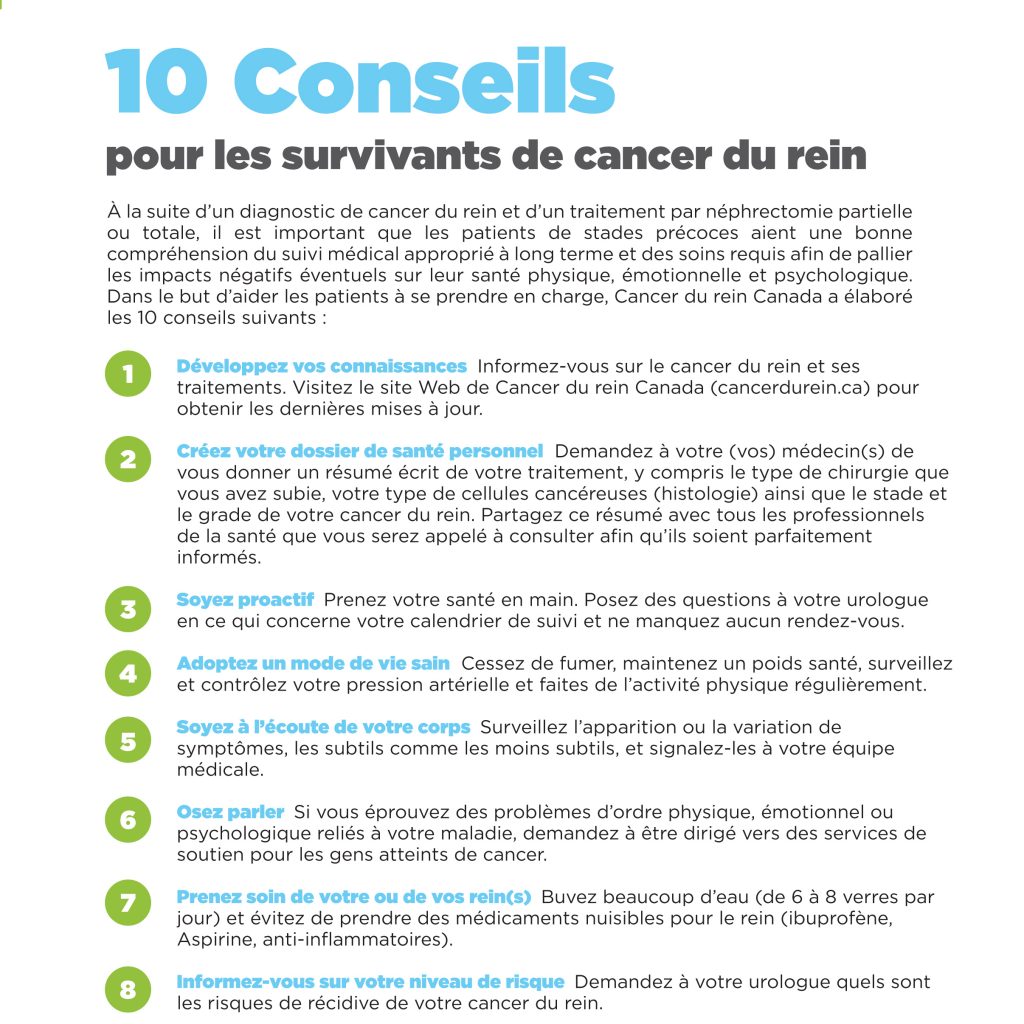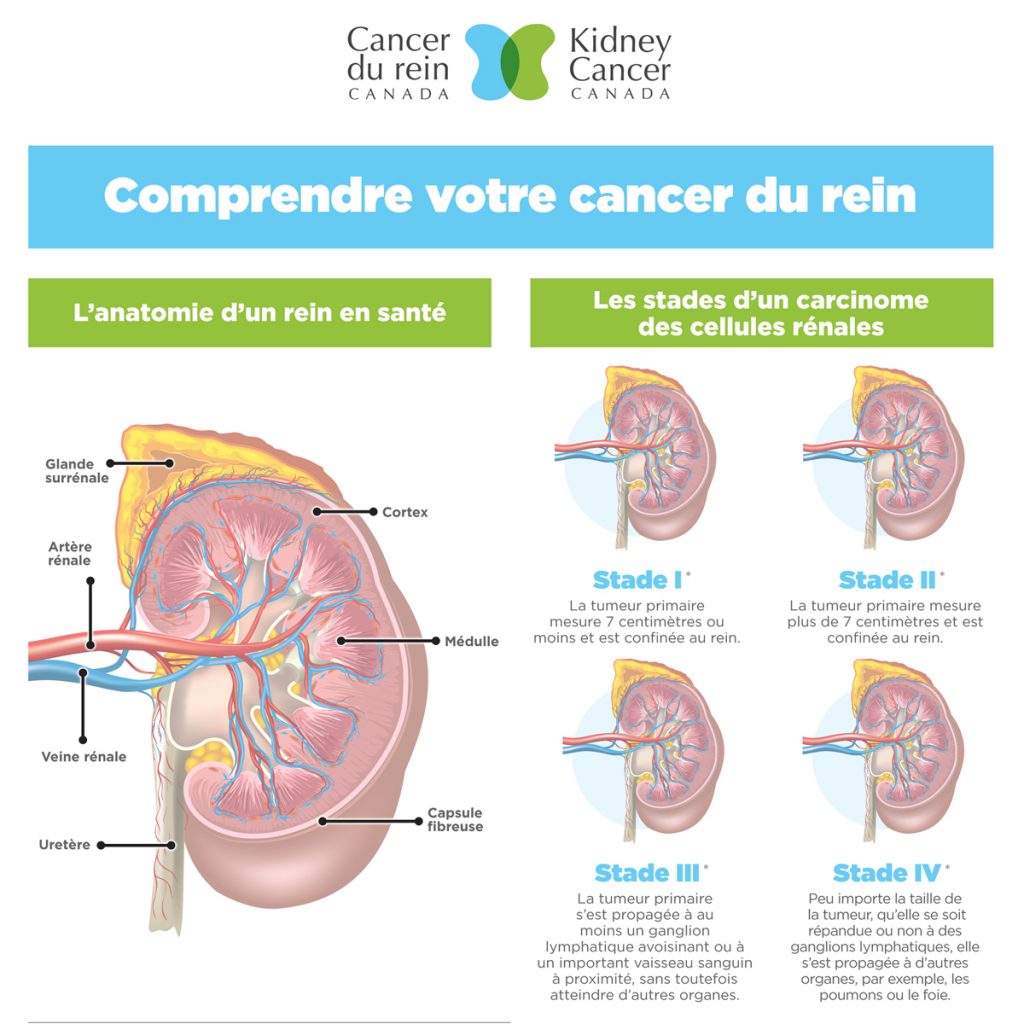Kidney cancer is a term that encompasses many different types of cancer that may arise in the kidney. The kind of kidney cancer that you may have depends on which cells of the kidney became abnormal or cancerous. The best treatment is based upon the type of kidney cancer you have and its size. In very rare cases, kidney cancer may be related to a hereditary disorder such as VHL Syndrome (see Genes, Genetics and Kidney Cancer )
Types of related kidney cancer related syndromes
The most common type of kidney cancer is called clear cell renal cell carcinoma (RCC). This accounts for up to 80% of kidney cancer. It is more common in men than women and usually occurs after age 55. Clear cell RCC is thought to arise from the cells that line the kidney tubules where urine is made. Through a microscope, the cells look clear and pale. This type of kidney cancer is usually due to a mutation in the von Hippel Lindau (VHL) gene. There are families with inherited mutations of VHL who develop kidney cancers in addition to other medical problems (see VHL Syndrome below). The majority of people, however, who develop clear cell RCC have a non-inherited or “sporadic” version. As a result of the medical research that has found this geneabnormality, there have been great advances in the treatment of this type of kidney cancer.
The second most common type is called papillary renal cell carcinoma (RCC). Papillary rcc accounts for about 15% of kidney cancers. The name is from microscopic finger-like projections (called papillae) in some, if not most, of the tumours.
TWO MAIN TYPES OF PAPILLARY KIDNEY CANCER
TYPE 1
Type 1 is generally less aggressive. There is a small subset of people who can inherit this type of papillary renal cell carcinoma. Papillary type I RCC, in both the sporadic and hereditary forms, is associated with a mutation of the MET oncogene. An oncogene is a gene in cells that promotes growth and this cancer is associated with abnormalities of the MET gene.
TYPE 2
Type 2 tends to be more aggressive, and in rare cases is part of a hereditary syndrome as well. Papillary type 2 tumors occur both sporadically and in patients who have the familial syndrome of hereditary leiomyomatosis and renal cell carcinoma (HLRCC). The genetic mutation associated with HLRCC is in the gene known as fumarate hydratase (FH).
SUGGESTED RESEARCH:
Hereditary Leiomyomatosis and Renal Cell Cancer (HLRCC) or Reed’s Syndrome : www.hlrccinfo.org – HLRCC Family Alliance
Hereditary Papillary Renal Cell Carcinoma : http://www.cancer.net/cancer-types/hereditary–papillary–renal–cell–carcinoma
Chromophobe renal cell carcinoma accounts for about 5% of RCC. Overall this is usually less aggressive than clear cell RCC and is usually confined to the kidney. However there are times it can be more serious and can spread.
SUGGESTED RESOURCES:
Information on Chromophobe rcc is scarce. Recommended resources include PubMed for recent articles. Suggestions for helpful resources would be most welcome (info@kidneycancercanada.ca)
Collecting duct renal cell carcinoma is a very rare sub type of kidney cancer. The major feature is that the cancer cells can form irregular tubes and starts in a different part of the kidney tubule. This tumour type is very aggressive, and has traditionally been treated with chemotherapy although the best treatment is not yet known.
SUGGESTED RESOURCES:
Information on Collecting Duct rcc is scarce. Recommended resources include PubMed for recent articles. Suggestions for helpful resources would be most welcome (info@kidneycancercanada.ca)
This accounts for about 5% of renal tumours. An oncocytoma is usually a solitary tumour that is benign. It is often diagnosed on biopsy or pathologically after treatment of presumed RCC . However, a form of oncocytic cancer, chromophobe RCC, can occur.
SUGGESTED RESOURCES:
Genetic translocation is a distinct form of kidney cancer that can occur in young adults (especially females) and probably children. It may make up approximately one-third of pediatric RCC. This can be diagnosed by special staining (immunohistochemical staining) of tissue from the kidney tumour. There are genetic abnormalities called translocations in the TFE3 gene (Xp11.2 translocation).
Approximately 10% to 15% of translocation RCCs occur in children who had prior chemotherapy for a prior cancer. Therefore translocation RCCs should be added to the list of chemotherapy-associated secondary cancers in children.
Renal medullary cancer is a rare yet aggressive cancer. It can be found in young adults that have sickle cell trait or rarely sickle cell disease, an inherited disease related to their haemoglobin in their red blood cells. In those with sickle cell trait the person carries one normal copy of the hemoglobin A gene (HbA) and one copy of the hemoglobin A gene harboring the genetic mutation found in sickle cell disease (HbS). These individuals do not have sickle cell disease but can develop kidney disease. These people may show visible (gross) hematuria (blood in the urine), abdominal or back/flank pain, abdominal mass, enlarged lymph nodes and significant weight loss.
Transitional cell carcinoma (TCC, more recently referred to as urothelial cell carcinoma or UCC) is a type of cancer that typically occurs in the lining of the urinary system – the kidney, bladder, and ureters). It is the most common type of bladder cancer and cancer of the ureter, urethra. It is the second most common type of kidney cancer (following renal cell carcinoma), but accounts for only five to 10 percent of all primary renal malignant tumors. Treatment is similar to that of bladder cancer and includes surgery and sometimes chemotherapy.
SUGGESTED RESOURCES:
Bladder Cancer Canada: http://bladdercancercanada.org/en/
Pediatric renal tumours
In children below age 15, RCC is quite rare. In this age group the most common renal cancer is Wilms disease. The next most common types of kidney tumour in children are: Clear cell RCC, clear cell sarcoma and rhabdoid tumours. Clear cell sarcoma is more likely to metastasize (spread) to the lungs, brain or bones than Wilms tumour. It is also more likely than Wilms tumour to come back or recur after treatment.
Wilms tumour can occur in families as a result of inherited genes. Most tumours are found in children around 3 years of age. Older children are less likely to get Wilms tumour. Above age 6, these tumours are rare.
People of African descent have the highest rates of Wilms’ tumour. Females are also more likely than males to develop the tumours. About 500 cases per year are diagnosed in the US. Wilms tumour occurs in otherwise healthy children. In 10% of cases occur in children with other developmental abnormalities. These include hemi-hypertrophy (abnormal growth on 1 side of the body) cryptorchidism (the absence of one or both testes from the scrotum), and hypospadias (a birth defect of the urethra in the male where the urinary meatus (opening) is abnormally placed. Symptoms can include abdominal mass, abdominal pain, blood in the urine, and fever of unknown cause.
Wilms tumour is a very curable cancer with 90% of patients surviving more than 5 years. It must be stressed that the treatment approach is vital to achieving a good response. A multi-disciplinary team consisting of pediatric specialists (pediatric surgeon/urologist,pediatric oncologist, pediatric radiation oncologist) that have extensive experience treating children with cancer is needed.
Pediatric clear cell renal carcinoma is a rare disease in children. RCC is more common than Wilms tumour after the age of 10 years. However, it is far less common overall than Wilms tumour. Conventional clear cell renal cell carcinomas make up about 15% of kidney cancers in children.
While in young adolescents age 15-19 renal cell carcinoma can account for 2/3 of kidney malignancies. They can present with similar findings as in adults. In this age group papillary renal cancer is more common than in adults. There is a unique type of renal cancer (genetic translocation cancer of the kidney) that can be found in young adults and probably children as well.



























































